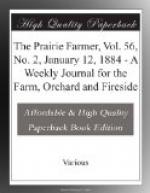New England Farmer: Prof. Goessmann, as Director of the State Experiment Station, has been analyzing a sample of rye hay, sent to the Station by Secretary Russell of the State Board of Agriculture. The sample was not cut till in full bloom, but Prof. Goessmann finds it compares well in nutritive value with a medium good quality of meadow hay. This agrees with our own estimate of well cured rye hay, judged by its effect in practical feeding to stock. Animals usually have to learn to eat it heartily, as they do many other kinds of coarse fodder which are inferior to the best hay. Rye should be cut before it comes in full bloom, to obtain the greatest feeding value from the fodder. It is then liked better, and a larger per cent will be digested.
Republican, Manhattan, Kan.: In traveling through a considerable portion of the country this week, we noticed that the wheat looked exceedingly promising. The contrast between the green fields and the dry grass and naked trees was cheering to behold. Cattle are in good condition; most of the farmers are provided with sheds or shelter of some sort to protect the animals, but we saw some small bunches of young cattle standing in unprotected enclosures shivering from the north wind; it is cruel to take them through the winter without so much as a wind break to turn off the scorching blasts. Surely every farmer can afford to build a wind break, at least a pile of brush and old hay, around the stock yards. The cost would be more than made up in the saving of feed.
They are growing some pretty heavy crops of wheat in New Hampshire. The Lebanon Free Press reports that Harlan Flint, of Hanover, raised this year eighty bushels of wheat on five acres of ground, and Uel Spencer, of the same town, 206 bushels from four and a half acres, while the town farm crop averaged forty-three bushels per acre. That raised by Mr. Flint was winter wheat, and Spencer’s White Russian. A Meredith correspondent of the Laconia Democrat says that eight farms adjoining each other, in that town, have produced this year 524 bushels of wheat. Reports from all sections of the State show that a great yield of wheat has been secured wherever the crop has been sown. Perhaps by the time the prairie skinners of the Northwest have spread over all the wheat bearing land this side of the Rocky Mountains, they may begin the New England States and travel the continent over again.
Correspondent Farm and Fireside: There is nothing so much needed about many houses as good walks in paths that must be used daily. There is hardly an excuse for not having them when either brick, gravel, or timber can be had. A good walk through muddy yards can be easily and cheaply made by placing poles side by side, a short distance apart, and then filling the intervening space with gravel, or with broken corn cobs, or with sawdust. Oak planks will last many years, if turned over occasionally, and this also counteracts warping. One of the best of walks




